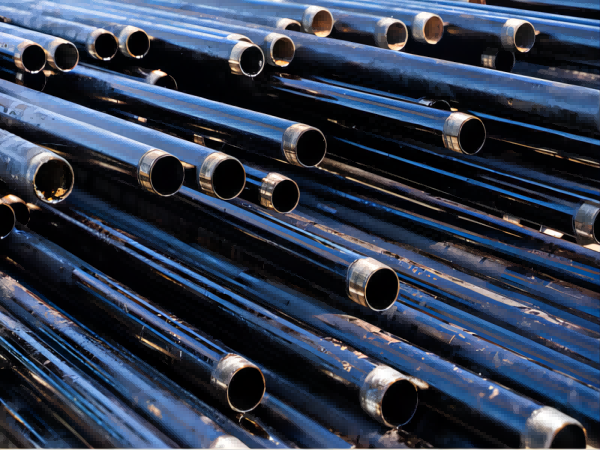There are 20 different steel grades and types of oil casings in H40, J55, K55, M65, N80, L80, C90, T95, C95, P110, Q125, in order to distinguish different steel grade strengths and thread types , using different color codes and symbols to represent the oil, steel grade and thread of the casing. The two or three digits behind the color code and the English letter indicate the minimum yield strength of the steel grade of the oil and casing, such as J55, which indicates that the minimum yield strength is 55,000 pounds/inch 2 (379Mpa) and the highest is 80,000 pounds/inch 2 ( 552Mpa), the minimum yield strength of P110 is 110,000 lbs/inch 2 (758Mpa) and the highest is 140,000 lbs/in 2 (965Mpa). H, J, K, N represent general strength oil casings, C, L, M, T represent limited yield strength oil casings, which have certain sulfur corrosion resistance.

The steel grade of the oil casing refers to the yield strength of the material, such as H40 means that the strength is 40*1000/145MPa=275.86MPa
Generally, J55 is used for surface casing in local area, N80 is used for oil layer casing, P110 is used for high-pressure layer, or P110 is used for the upper part of the well. There are 20 different steel grades and types of oil casings in H40, J55, K55, M65, N80, L80, C90, T95, C95, P110, Q125, in order to distinguish different steel grade strengths and thread types , using different color codes and symbols to represent the oil, steel grade and thread of the casing. The two or three digits behind the color code and the English letter indicate the minimum yield strength of the steel grade of the oil and casing, such as J55, which indicates that the minimum yield strength is 55000 lb/in2 (379Mpa) and the maximum is 80000 lb/in2 ( 552Mpa), the minimum yield strength of P110 is 110,000 lbs/inch 2 (758Mpa) and the highest is 140,000 lbs/in 2 (965Mpa). H, J, K, N represent general strength oil casings, C, L, M, T represent limited yield strength oil casings, which have certain sulfur corrosion resistance.
The delivery pressure of the pipeline medium tends to increase gradually, especially on the gas pipeline. This is because increasing the delivery pressure within a certain range will increase the economic benefits. Taking the gas pipeline as an example, under the condition of constant delivery, the flow velocity decreases with the increase of the delivery pressure and the density of the gas increases, so that the frictional resistance decline.
Conveyance pressure tends to gradually increase due to concerns about reducing energy consumption. In the early days, the transmission pressure of natural gas pipelines in Sichuan Province was 2.5MPa, and later increased to 4MPa, the Shaanxi-Beijing line increased to 6MPa, and the west-to-east gas pipeline increased to 10MPa. Nearly ten gas pipelines in foreign economically developed countries mostly choose 12MPa.
The pressure ratio on the gas pipeline also tends to decrease gradually. The so-called pressure ratio refers to the ratio of the inbound pressure to the outbound pressure. A reduction in the pressure ratio means that the entire line is operating at a higher pressure, which can also reduce energy consumption. The early pressure was mostly 1.6, and later dropped to 1.4. In recent years, some foreign gas pipelines have a pressure ratio of 1.25. Of course, if the pressure ratio is reduced, the number of compressor stations will increase, and thus the investment will increase. For pipe diameter, pressure and pressure ratio, optimization calculation and comparison are required.
When the output is determined and the pipe diameter, pressure, and pressure ratio are determined through optimization, if a higher pressure is selected but the steel strength grade is too low, the wall thickness will be too large, which will bring problems to many links such as pipe making, on-site welding, and transportation. It is difficult, even impossible to achieve. The demands of production have driven the increase in steel grades.
API released the APl5L standard in 1926, initially only including three steel grades A25, A, and B, and the minimum yield values were 172, 207, and 251MPa respectively. API released the APl5LX standard in 1947, which added three steel grades of X42, X46 and X52, and their minimum yield values were 289, 317 and 358MPa respectively. Since 1966, four steel grades, X56, X60, X65, and X70, have been released successively, and their minimum yield values are 386, 413, 448, and 482MPa respectively. In 1972, API released U80 and U100 standards, and their minimum yield values were 551 and 691Mpa respectively. Later, API changed U80 and U100 to X80 and X100. According to rough statistics, before 2000, the consumption of X70 in the world was about 40%, and that of X65 and X60 hovered around 30%. A considerable number of small-diameter oil product pipelines also used X52 steel grade, and most of them were ERW steel pipes.